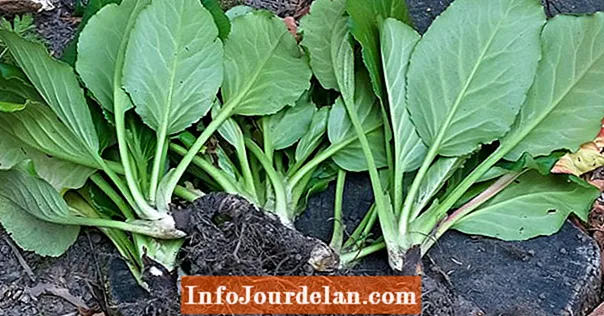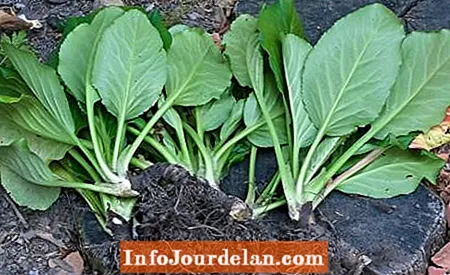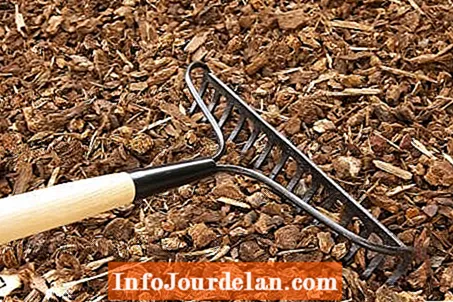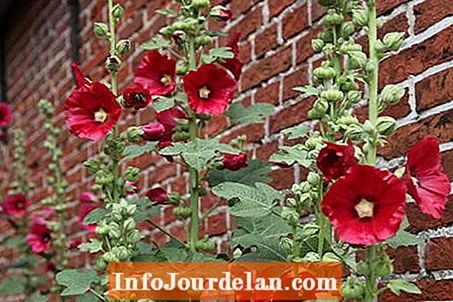
Content
Planting dahlias, sowing a meadow of flowers, cutting lilacs: in our gardening tips for the ornamental garden in May you will find the most important tasks at a glance.

In our gardening tips for the ornamental garden in May, we have summarized all the important gardening work that is on the plan this month. After the ice saints, when there is no longer any risk of frost, summer-flowering bulbs and tubers such as dahlias or gladioli can be put into the ground. In addition, May is perfect for sowing a meadow of flowers.
The heyday of the Bergenia unfortunately comes to an end in May. The good news is that you can divide and replant plants that have grown too large afterwards. Use a digging fork or spade to get the plants out of the bed. Gently pull the rhizomes apart with your hands. When planting, make sure that each rhizome has at least one pair of leaves. Without leaves, it is difficult for the rhizomes to sprout again. The planting distance should be around 30 centimeters.

May is a good month to plant a flower meadow. Dig up the area, chop up coarse clods of earth with a cultivator and level the area with a rake so that a fine-crumbly seedbed is created. A hay rake made of wood or aluminum is best for this. The seeds are sown according to the instructions on the package, lightly raked in and kept evenly moist after sowing until they germinate. Important: Only use seed mixtures that are tailored to your soil conditions - a flower mixture for lean sandy soils, for example, disappears within a few years if it is sown on a moist clay soil.
A flower meadow provides plenty of food for insects and is also pretty to look at. In this practical video, we will show you step by step how to properly create such a flower-rich meadow.
Credits: Production: MSG / Folkert Siemens; Camera: David Hugle, Editor: Dennis Fuhro; Photo: MSG / Alexandra Ichters
In May at the latest, it will be clear which plants have survived the cold season unscathed. On the one hand, botanical departures hurt, on the other hand they offer newcomers a chance. If you don't want to wait for weeds or short-lived plants such as columbines, mullein and Patagonian verbena to close the gaps, you can now plant what was previously no space. Suitable perennials for shady corners are, for example, splendid sparrows (Astilbe), cranesbills, lady's mantle and purple bells (Heuchera). Sunny areas can be embellished with permanent blooms such as magnificent candles (Gaura), scented nettles (Agastache), catnip, girls' eyes and pigeon scabiosis.
Would you like to know which gardening work should be at the top of your to-do list in May? Karina Nennstiel reveals that to you in this episode of our podcast "Grünstadtmenschen" - as usual "short & dirty" in just under five minutes. Have a listen right now!
Recommended editorial content
Matching the content, you will find external content from Spotify here. Due to your tracking setting, the technical representation is not possible. By clicking on "Show content", you consent to external content from this service being displayed to you with immediate effect.
You can find information in our data protection declaration. You can deactivate the activated functions via the privacy settings in the footer.
The water in the garden pond has the right temperature in May to plant new water lilies. Place the water lilies in special plant baskets with water lily soil and lower the baskets to the correct water depth for the respective water lily. Damaged and dead leaves should be removed before planting and the surface of the pot should then be protected from floating with a layer of gravel. It is best to line large-meshed lattice pots with fleece or sackcloth so that the water lily soil is not washed out.

Every few years the irises in the garden pond have spread so much that they have to be divided. After flowering, lift the plants including the planting basket out of the water and use a knife or a sharp spade to divide the rhizomes into fist-sized pieces of rhizome with at least one tuft of leaves. Shorten the leaf pods with a knife to a hand's breadth above the root ball and then put the pieces back in the planting baskets with fresh soil. Important: do not set the rhizome pieces too deep! They should only be lightly covered with earth.
When the lilacs have withered at the end of May, you should cut off the withered panicles above the next branch. A more vigorous pruning is recommended every few years, because otherwise the bushes can easily become blooming and age.
A mulch layer in the bed has many advantages: It supplies the soil with humus, keeps it loose and moist for longer. The beginning of May is the best time to apply them, because the soil has now warmed up sufficiently. Chopped wood, bark mulch or bark compost have proven themselves. Important: Before covering the soil, spread plenty of horn shavings, as the decomposition processes in the nutrient-poor mulch layer bind a lot of nitrogen.

Black star soot is the most common rose disease. Affected leaves have irregularly shaped, gray-black spots of different sizes with radial edges. At the first signs of an infestation, you should treat your roses with fungicides immediately, otherwise there is a risk of massive leaf fall. If your rhododendrons have brown-black, dried-up flower buds, you should remove them by the beginning of May at the latest. Reason: The buds contain the clutches of the rhododendron cicada. Depending on the weather, the pests often hatch from the end of April and then attack the new flower buds in June / July. It is best to dispose of the dead buds with household waste.
From mid-May you can sow frost-sensitive summer flowers such as nasturtiums and marigolds directly into the bed. These bloom later than their colleagues who are drawn to the windowsill, but you also have a lot less work to do. Hollyhocks, like foxgloves and beard carnations, are biennial plants. With early preculture in the greenhouse, they can bloom in the same year. However, it is easier to sow the short-lived plants directly outdoors in May or June. The seed in the loosened bed is thinly covered with some earth and watered. The first seedlings will appear after two to three weeks. In the first season these only form leaves. In the next spring they start with well-developed rosettes and then show their bloom all summer.

To extend the flowering time of various perennials beyond the usual time, you can use the so-called "Chelsea Chop". The new flower shoots of perennials such as sedum plant, upright species of cranesbill and catnip are shortened by about a third. This leads to a postponement of the flowering time of several weeks, more abundance of flowers and a more compact and bushy growth. The clippings also supply hobby gardeners with cuttings for their own cultivation.
The bleeding heart withdraws into its roots immediately after flowering and has usually disappeared by mid-summer. If you want to extend the plant's growing season, simply water it regularly. If you follow this gardening tip, you can delay the yellowing of the leaves by about two weeks.

In particular, perennials and perennials at the edge of the forest do not like it when their root area is constantly being worked through with a hoe. It is better to plant your perennials with the correct spacing so that the carpet of plants closes within a few years and hardly lets weeds through. Until then, you should hand out all weeds and mulch the area if necessary to keep the soil moist and suppress new weeds. Another garden tip: after weeding the herbaceous bed, you should carefully loosen the soil with a trident (cultivator). As a result, sun-loving seeds lying on the ground are "buried under" and tiny weed seedlings remaining in the ground are uprooted.
As soon as the blaze of colors of tulips and daffodils is over, the withered inflorescences are cut off. This is by no means for optical reasons. Rather, the care measure protects the plants from putting all their energy into seed formation. This is especially true for large-flowered varieties. Important: Let the leaves stand and only remove them when they are dry and yellowed. This contains nutrients that are absorbed and stored by the onions. So the early bloomers can get off to a good start again next year.
Wild shoots often form on roses and grow out of the earth near the base. They have to be torn off directly at the trunk, otherwise wild shoots will grow again from the remaining buds. The following technique has proven itself: Carefully dig the root neck free, then cut horizontally into the bark under the game shoot with a sharp knife and tear off the shoot downwards. With the short horizontal cut, you prevent the wounds from becoming too large.

In May you have to prune the fresh shoots of your topiary for the first time. It is best to use cordless shrub shears or small hand hedge trimmers for this. You should work out particularly detailed contours with normal secateurs or sheep shears. It doesn't always have to be boxwood and yew. Other woody plants such as the mountain pine (Pinus mugo) and their varieties can be shaped into balls or garden bonsai. To this end, the young shoot candles are trimmed to around a third every year in May. This is done either with scissors or, even better, by breaking it out by hand. Then you won't see any unsightly brown needles later. Admittedly, it is quite laborious manual work, but this way the trees stay nice and compact for years.
At the beginning of May, the overwintered dahlia bulbs come back into the ground - ideally in a sunny location with sandy soil. If their flowering pleasure has diminished in recent years, you should reduce the new shoots and only leave the strongest ones. Alternatively, you can divide the tubers before planting them out, this also stimulates the flower formation.

After the ice saints, in mid-May, gladioli are allowed back into the bed. To do this, check all tubers for plant diseases and pests before planting. Then they come eight to ten centimeters deep into the earth. Further gardening tips: In summer it is important that the soil does not dry out completely. Gladioli do not tolerate waterlogging! To prevent soil fatigue, you should move the tubers to a different place every year.
Flowering bushes that you propagated with cuttings in January usually have new shoots for a long time in May. Now cut these back by about two thirds with sharp secateurs and then provide the young plants with a little fertilizer. This gives them another growth spurt and branches well right from the start.